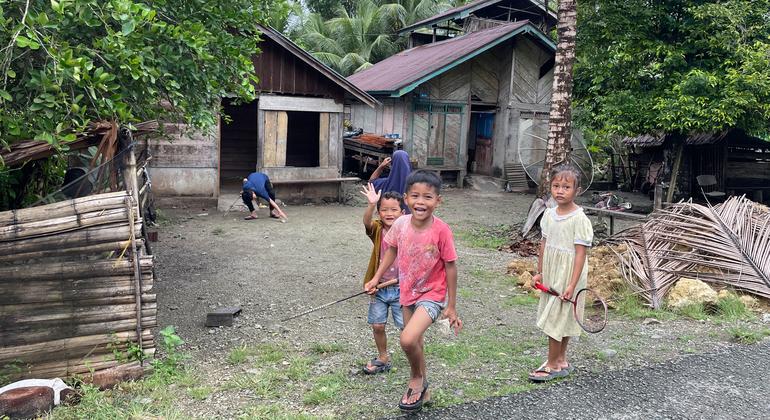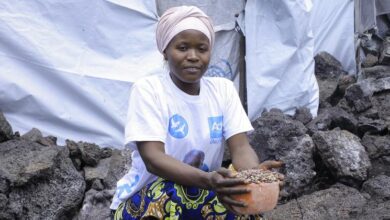Twenty years on: Indonesia ‘better prepared’ after tsunami

The song’s lyrics include references to an earthquake, a large wave, land being submerged under water, and navigating to higher ground.
“When there are earthquakes and tsunamis, you panic and can’t think. This is why emergency drills must be ingrained and become second nature. This must start from a young age,” Ahmadi said.
Despite being the closest inhabited island to the epicenter of the December 2004 earthquake that triggered the largest tsunami ever this century, only six residents died on the island’s 100,000 people, a lower rate than any other affected area.
“This is because local wisdom is passed from generation to generation in one form dust”, said local leader Teuku Reza Fahlevi, referring to indigenous knowledge related to tsunamis.

A woman watches her village in Indonesia destroyed by a tsunami.
This oral tradition has helped their people adapt better to natural disasters. For example, in 2004, they learned to run to higher ground when the sea level receded, saving many lives.
“In many other coastal areas of the country, people rushed to the seabed to retrieve fish and were crushed by rising seas as waves up to 30 meters high caused devastation and destruction,” he said.
Be better prepared when disaster strikes
Twenty years on, Aceh province in far western Indonesia is much more prepared. Smong is now part of the curriculum of every elementary and middle school in Simeulue as well as in several other districts,
“To be fully prepared, we cannot rely solely on grandparents but must ensure that every child is prepared,” Ahmadi said.

Indonesia’s low-lying coastal areas are vulnerable to tsunamis.
The Provincial Storytellers Association is working with the Simeulue Board of Education to lobby the remaining governments to do the same.
Ahmadi himself was living in the provincial capital Banda Aceh when the 2004 tsunami hit and immediately fled to higher ground. He tried to persuade many neighbors to do the same but most did not listen.
“When I turned around, I saw dead bodies everywhere,” he said. “Today, the loss of life would be much smaller – we are much better prepared.”
More than 167,000 people died in Indonesia during the events of December 26 and at least 60,000 more in other countries across the Indian Ocean.
The United Nations, at the request of the Indonesian government, provided major relief assistance to survivors.

A woman in Indonesia searches through rubble at a beach in Palu, Indonesia, which was completely washed away by a tsunami in October 2018. (document)
Ten UN agencies were involved in this work, from the International Organization for Migration (IOM) to help internally displaced people, to the United Nations Children’s Fund (UNICEF) provides emergency supplies to children and the United Nations Development Program supports reconstruction efforts.
United Nations Office for the Coordination of Humanitarian Affairs (OCHA) supported the emergency response phase in 2004 and with partners has advocated the importance of building community resilience through disaster education since 2006 based on best international rules.
OCHA, along with other United Nations agencies, the Red Cross, universities, the private sector and NGOs, remained engaged long after the tsunami to support Indonesia and the province. Aceh in improving its preparedness to respond to natural disaster risks.
Structured disaster management

to Indonesian children practice tsunami preparedness drills at school.
The tsunami ushered in a new era of more systematic and structured disaster management across the country, based on international best practices.
Regulations have been put in place to establish and streamline processes for providing health care and food services in the event of natural disasters, and to establish local agencies to coordinate humanitarian efforts. religion on the ground.
The National Disaster Management Authority (BNBP) has increased engagement with stakeholders in emergency response, recovery and development to implement global policies.
“We believe that disaster risk reduction, sustainable development and climate change must be addressed comprehensively,” said Raditya Jayi, Deputy Minister of the National Disaster Management Authority (BNBP). . “Sustainable resilience ensures that we protect our development gains by investing in building resilience.”
The country has integrated post-2015 frameworks on Sustainable Development (SDGs), UNFCCC Paris Agreement and Sendai framework for disaster risk reduction 2015-2030, an international agreement adopted by United Nations member states at the United Nations Third World Conference on Disaster Risk Reduction in 2015.
Thandie Mwape, Director of OCHA Indonesia said: “There have been great strides by the central and provincial governments, supported by multi-stakeholder partners, including community and religious organizations, in strengthening preparedness”.
Focus areas include education and regular tsunami preparedness drills that have been mandatory in all schools in the province since 2010, she said. Implementation of the school program Disaster safety measures were implemented nationwide in 2012, further enhancing preparedness.
A siren system has been installed in several provinces and people have been educated on what to do in case the alarm goes off.
Now, thanks to progress in disaster management in the country, the National Humanitarian Team, which includes the United Nations, development partners and local NGOs, is focusing on supporting the government in strengthening disaster prevention capacity and enhancing preventive action, as well as applying best practices from Indonesia to countries in the region and around the world.
“Indonesia is a knowledge hub and there is much the world can learn from here, lessons that will help save lives,” Ms. Mwape said.
Support of United Nations agencies in the emergency response in Indonesia following the 2004 tsunami
- United Nations Office for the Coordination of Humanitarian Affairs (OCHA):
- Coordinate international response efforts and facilitate aid distribution.
- United Nations Children’s Fund (UNICEF):
- Providing emergency necessities such as clean water, sanitation, health care, nutrition and education for children.
- World Food Program (WFP):
- Provide food aid to affected people and provide logistical support and transportation of relief goods
- World Health Organization (WHO):
- Address public health concerns, provide medical supplies, and help rebuild medical infrastructure.
- United Nations High Commissioner for Refugees (UNHCR):
- Providing shelter and protection for displaced people.
- United Nations Development Program (UNDP):
- Support early recovery efforts, including debris removal, rebuilding infrastructure, and restoring livelihoods.
- International Organization for Migration (IOM):
- Provide assistance to displaced people, including temporary housing and transportation.
- Food and Agriculture Organization of the United Nations (FAO):
- Support the recovery of the agricultural and fisheries sectors to restore food security.
- United Nations Population Fund (UNFPA):
- Focus on reproductive health services and support for women and girls affected by natural disasters.
- United Nations Educational, Scientific and Cultural Organization (UNESCO):
- Work on early warning systems and disaster prevention education.




